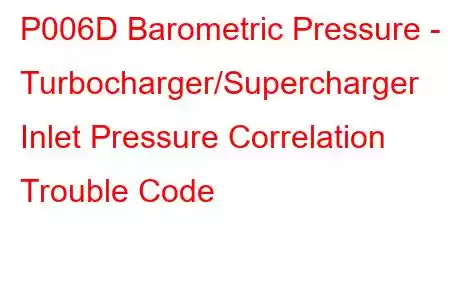P006D Barometric Pressure - Turbocharger/Supercharger Inlet Pressure Correlation
OBD-II Trouble Code Technical Description
Barometric Pressure - Turbocharger/Supercharger Inlet Pressure Correlation
What does that mean?
This generic powertrain diagnostic trouble code (DTC) typically applies to many OBD-II vehicles. That may include but is not limited to vehicles from Dodge, Cadillac, Fiat, Jeep, Nissan, Chrysler, etc.
A stored code P006D means that the powertrain control module (PCM) has detected a discrepancy in the correlating signals between the barometric pressure sensor and the turbocharger/supercharger inlet pressure sensor.
The code P006D is applicable exclusively to vehicles with forced air induction systems. Other stored barometric pressure sensor or forced air induction system codes should be diagnosed and repaired before attempting to diagnose a code P006D.
Barometric pressure (air density) is measured in either kilopascal (kPa) units or inches of mercury (Hg), utilizing the barometric pressure sensor. These measurements are input to the PCM as varying degrees of voltage. Barometric pressure and barometric pressure signals are measured in similar increments.
The turbocharger/supercharger inlet pressure sensor will typically be of a similar design to the barometric pressure sensor. It also monitors air density. It is most often positioned inside the turbocharger/supercharger inlet hose and it provides the PCM with an appropriate voltage signal reflecting such.
If voltage input signals (between the barometric pressure sensor and the turbocharger/supercharger inlet pressure sensor) differ by more than a programmed degree (over a certain period of time and under a particular set of circumstances), a code P006D will be stored, and a malfunction indicator lamp (MIL) may be illuminated.
In some vehicle applications, MIL illumination may require multiple drive cycles with a failure. Exact parameters for code storage (as it relates to the vehicle in question) can be obtained by consulting a reliable vehicle information source (such as AllData DIY).
What is the severity of this DTC?
Engine performance, drivability, and fuel efficiency will likely be hindered by the conditions which contribute to storage of a code P006D. It must be addressed with urgency.
What are some of the symptoms of the code?
Symptoms of a P006D engine code may include:
Reduced engine performance Decreased fuel efficiency Delayed engine acceleration A rich or lean condition Louder than normal hissing/suction noise upon accelerationWhat are some of the common causes of the code?
Causes for this engine code may include:
Defective barometric pressure sensor Faulty turbocharger/supercharger inlet pressure sensor Open or shorted wiring or connector Insufficient engine vacuum Restricted air intake PCM or PCM programming errorWhat are some P006D troubleshooting steps?
I would begin with a visual inspection of all barometric pressure sensor and turbocharger inlet pressure sensor wiring and connectors. I would also make sure that the turbocharger/supercharger inlet hoses are secure and in working order. Additionally, I would inspect the air filter. It must be relatively clean and clear of obstruction.
When diagnosing a code P006D, I would need a manual vacuum pressure gauge, a diagnostic scanner, a digital volt/ohmmeter (DVOM), and a source of reliable vehicle information.
A reasonable precursor to any barometric pressure sensor related code is a manual engine intake vacuum pressure test. Use the vacuum pressure gauge and get specification guidelines from your vehicle information source. If engine vacuum is insufficient, there is an internal engine malfunction that must be rectified before proceeding.
Now, I would connect the scanner to the vehicle diagnostic port and retrieve al
Read: 50


